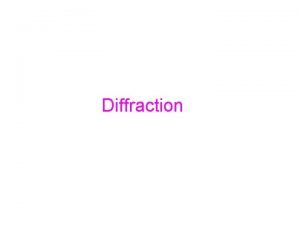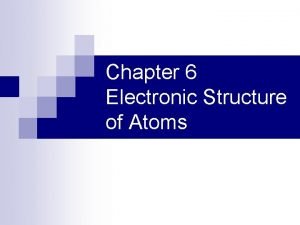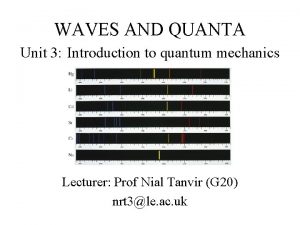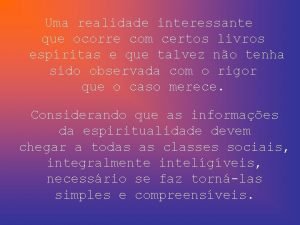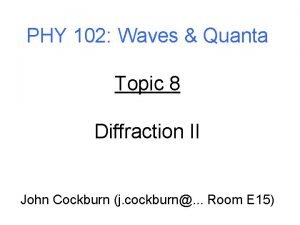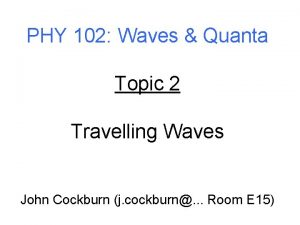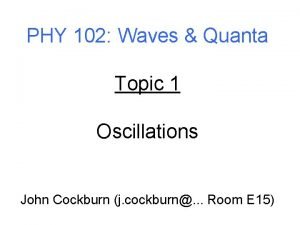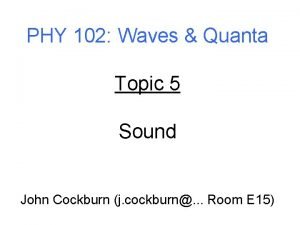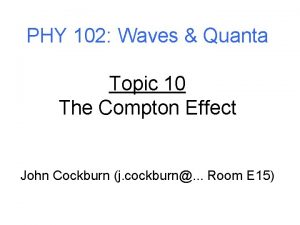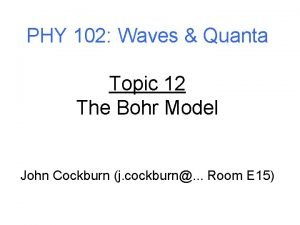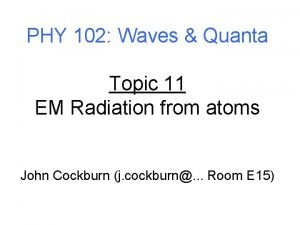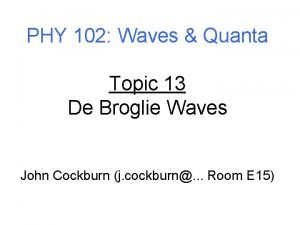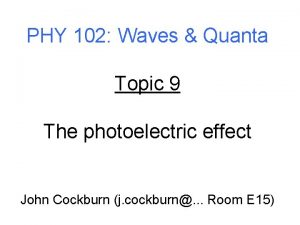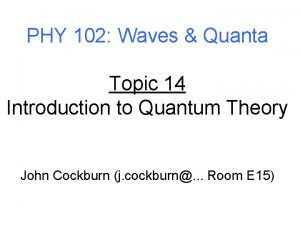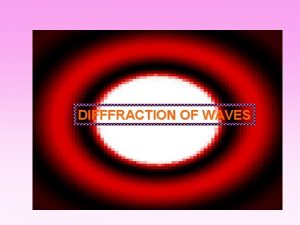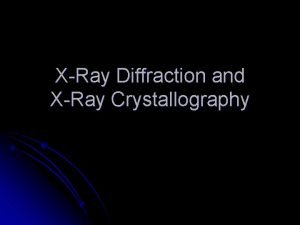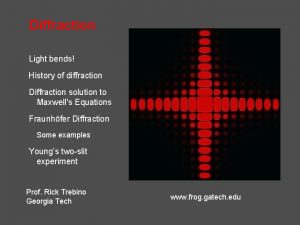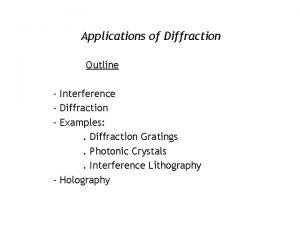PHY 102 Waves Quanta Topic 7 Diffraction John




























- Slides: 28

PHY 102: Waves & Quanta Topic 7 Diffraction John Cockburn (j. cockburn@. . . Room E 15)

• Interference re-cap • Phasors • Single slit diffraction • Intensity distribution for single slit

Electromagnetic Waves Where E 0 and B 0 are related by: E 0 = c. B 0 INTENSITY of an EM wave E 02 NB. we will see later that EM radiation sometimes behaves like a stream of particles (Photons) rather than a wave………………

Interference First, consider case for sound waves, emitted by 2 loudspeakers: Path difference =nλ Constructive Interference Path difference =(n+1/2)λ Destructive Interference (n = any integer, m = odd integer)

Interference

Young’s Double Slit Experiment • Demonstrates wave nature of light • Each slit S 1 and S 2 acts as a separate source of coherent light (like the loudspeakers for sound waves)

Young’s Double Slit Experiment Constructive interference: Destructive interference:

Young’s Double Slit Experiment Y-position of bright fringe on screen: ym = Rtan m Small , ie r 1, r 2 ≈ R, so tan ≈ sin So, get bright fringe when: (small only)

Young’s Double Slit Experiment: Intensity Distribution For some general point P, the 2 arriving waves will have a path difference which is some fraction of a wavelength. This corresponds to a difference in the phases of the electric field oscillations arriving at P:

Young’s Double Slit Experiment: Intensity Distribution Total Electric field at point P: Trig. Identity: With = ( t + ), = t, get:

So, ETOT has an “oscillating” amplitude: Since intensity is proportional to amplitude squared: Or, since I 0 E 02, and proportionality constant the same in both cases:

For the case where y<<R, sin ≈ y/R:

Young’s Double Slit Experiment: Intensity Distribution

2 -slit intensity distribution: “phasor” treatment • Remember from Lecture 1, harmonic oscillation with amplitude A and angular frequency can be represented as projection on x or y axis of a rotating vector (phasor) of magnitude (length) A rotating about origin. Light • We can use this concept to add oscillations with the same frequency, but different phase constant by “freezing” this rotation in time and treating the 2 oscillations as fixed vectors…… • So called “phasor method”

2 -slit intensity distribution: “phasor” treatment Use phasor diagram to do the addition E 1 + E 2 Using cosine rule:

Another way: Complex exponentials

Another way: Complex exponentials

Single Slit Diffraction “geometrical” picture breaks down when slit width becomes comparable with wavelength

Single Slit Diffraction observed for all types of wave motion eg water waves in ripple tank

Single Slit Diffraction

Single Slit Diffraction • Explain/analyse by treating the single slit as a linear array of coherent point sources that interfere with one another (Huygen’s principle)…………. All “straight ahead” wavelets in phase → central bright maximum Fraunhofer (“far-field”) case Destructive interference of light from sources within slit for certain angles

Single Slit Diffraction • From diagram, can see that for slit of width A, we will get destructive interference (dark band on screen) at angles which satisfy…. . : Choice of a/2 and a/4 in diagram is entirely arbitrary, so in general we have a dark band whenever; (m=± 1, ± 2, ± 3………. . )

Position of dark fringes in single-slit diffraction If, like the 2 -slit treatment we assume small angles, sin ≈ tan =ymin/R, then Positions of intensity MINIMA of diffraction pattern on screen, measured from central position. Very similar to expression derived for 2 -slit experiment: But remember, in this case ym are positions of MAXIMA In interference pattern

Width of central maximum • We can define the width of the central maximum to be the distance between the m = +1 minimum and the m=-1 minimum: Intensity distribution image of diffraction pattern Ie, the narrower the slit, the more the diffraction pattern “spreads out”

Single-slit diffraction: intensity distribution To calculate this, we treat the slit as a continuous array of infinitesimal sources: Can be done algebraically, but more nicely with phasors………………. .

Single-slit diffraction: intensity distribution E 0 is E-field amplitude at central maximum = total phase difference for “wavelets” from top and bottom of slit

Single-slit diffraction: intensity distribution How is related to our slit/screen setup? Path difference between light rays from top and bottom of slit is From earlier (2 -slit)

Single-slit diffraction: intensity distribution
 Hablar com deus
Hablar com deus Eu quero falar com deus
Eu quero falar com deus Huygens principle
Huygens principle The phenomenon of diffraction can be understood using *
The phenomenon of diffraction can be understood using * Se cres em deus se acreditas que ele ha de voltar
Se cres em deus se acreditas que ele ha de voltar Quanta plastica finisce in mare ogni anno
Quanta plastica finisce in mare ogni anno Chem
Chem Which of the d orbitals most resembles a pz orbital?
Which of the d orbitals most resembles a pz orbital? Quanta unit
Quanta unit Quanta paz
Quanta paz Allegra aggettivo
Allegra aggettivo Quanta namera
Quanta namera Parts of a longitudinal wave
Parts of a longitudinal wave Electromagnetic waves are transverse waves true or false
Electromagnetic waves are transverse waves true or false Mechanical wave
Mechanical wave What is a rainbow
What is a rainbow The wave chapter 13
The wave chapter 13 Is echolocation transverse or longitudinal
Is echolocation transverse or longitudinal Short wave vs long wave radiation
Short wave vs long wave radiation Difference between matter waves and electromagnetic waves
Difference between matter waves and electromagnetic waves Mechanical vs electromagnetic waves
Mechanical vs electromagnetic waves Mechanical waves and electromagnetic waves similarities
Mechanical waves and electromagnetic waves similarities Seismic waves
Seismic waves Is a seismic wave mechanical or electromagnetic
Is a seismic wave mechanical or electromagnetic Compare and contrast p waves and s waves using venn diagram
Compare and contrast p waves and s waves using venn diagram Mechanical waves vs electromagnetic waves venn diagram
Mechanical waves vs electromagnetic waves venn diagram The difference between constructive and destructive waves
The difference between constructive and destructive waves Clueing topic sentence
Clueing topic sentence Broad and specific topic examples
Broad and specific topic examples



